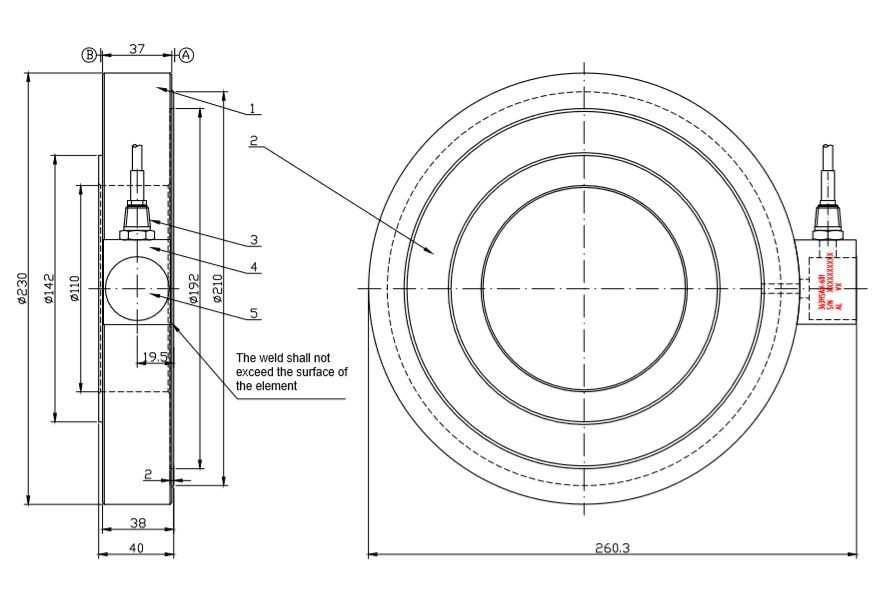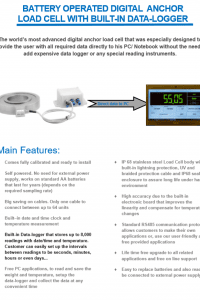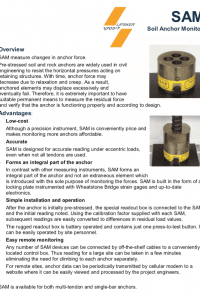SAM-SOIL ANCHOR MONITOR
Soil anchors including a permanent, integral, residual force monitoring system.
It is a well known fact that the biggest fear of any planner and soil assessor, particularly in regard to permanent soil anchors, is that over time and even if the execution of the design is perfect, for geological or other reasons, the anchor might lose its retaining force, which could endanger the stability of the supported building, retaining wall or any other structure.
The contractor’s signed undertaking that the permanent anchors as installed by that contractor will maintain the necessary retaining force for a period of 20 to 30 years is worthless. We, the Lipsker Company, have signed an undertaking at the Bahai Project in Haifa, guaranteeing anchor load bearing for a period of 300 years.
It is standard practice for projects with a large number of permanent anchors to install hydraulic or electrical pressure cells to check loads on 5% - 10% of the anchors. The systems currently available in the marketplace are very expensive and constitute another item of equipment attached to the anchor head. They are difficult to install in the non-protruding manner that ensures they will not be damaged. Our company offers a much better alternative, constructed in the form of a system, which is an integral part of the anchor; it does not protrude and there is no need to create a special space to accommodate the system. After making a simple connection to the wires and pressing the button on the monitor, a digital readout displays the force on the anchor at any height and any location.
It is well-known that a properly executed soil anchor, tested at working load with an additional safety factor and locked at the planned load, is almost the ideal solution for the support of buildings and retaining walls. However, to complete the picture and ensure maximum safety after investing so much in fixing the anchor in place, we still lack information and the ability to check anchor residual load status at any time. We need to know the residual force, if anchor force has decreased and if appropriate steps must be taken to remedy the situation.
We offer a low cost solution for the construction of the ideal anchor, with perfect residual force monitoring.
It must be noted that even if the planners' stipulate the installation of our residual force testing system on all the permanent anchors, the extra cost per anchor will be significantly lower due to the advantages of quantity. In fact, every technical specification for the execution of permanent anchors includes a demand for residual force testing after a period of a week, a month, six months, etc. Therefore it is often true that after completing excavation, very sizable additional sums must still be invested in the use of cranes, scaffolding and many other types of lifting equipment and hanging platforms. If our system is used, those costs will be saved and in practice, they will be offset against the higher price for our system and measurements.
We are ready to sell complete anchors to any contractor, including anchor heads with the Lipsker integral residual force testing system. Alternatively, contractors can choose just the anchor head including the residual force testing system. Regarding Lipsker anchors - We have successfully executed the positioning of more than 100 units for a range of projects such as the Ayalon Highway and others.
It is important to note that in many instances, it is worthwhile using anchors with residual force testing systems, even when installing temporary anchors.
In projects with multiple rows of anchors, which will take a long time to install, it is a good idea to install a number of anchors with our system in each row for monitoring purposes. Often and for a variety of reasons, the executing contractor does not complete construction after the first excavation. This creates safety problems, because only temporary anchors are in place. Considerable additional investment will be required for the building of scaffolding, the use of cranes and other lifting equipment, in order to check the existing anchors. As contractors ourselves, we have worked through that process many times. We believe that it is possible to avoid that expense by including a number of anchors fitted with our testing systems. After restarting construction work, the anchor heads can be dismantled and re-used, which is another advantage when installing anchors fitted with the Lipsker residual force monitoring system.
To summarize: As someone who has invested more than 50 years of his life executing soil engineering projects; as the person who installed the first soil anchors in Israel and as one who has throughout those years constantly persevered in the development and improvement of equipment and methods; I address all those involved in the field: I suggest that you add to your anchors, especially permanent anchors, the very equipment that is missing in order to make it perfect. Equip your anchors with the ability to be monitored at all times and ensure their maximum safety.
Itzchak Lipsker-General Manager.
Lipsker&Co.
Engineering Services (1975) Ltd.




